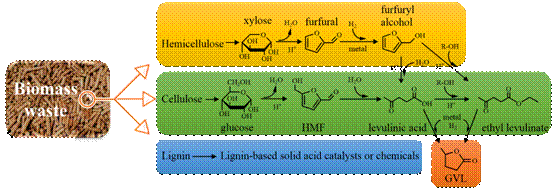Review Articles about Biomass Resource Valorization into Renewable Energy and Chemicals Published
As a natural renewable resource, the catalytic conversion of lignocellulosic biomass is considered to be an important strategy to alleviate the tremendous dependence on fossil resources. The synthesis of γ-valerolactone (GVL), which is hailed as a new-generation of biomass-based platform molecules, and its derived valeric biofuels is believed to be one of the pivotal steps in the transformation of biomass resources into liquid fuels and high-value chemicals.
Prof. Lu Xuebin’s team from the School of Environmental Science and Engineering has long been committed to the research on high-efficiency catalytic systems for the synthesis of GVL and its derived valerate esters. Recently, they have systematically reviewed the development of this hot topic and further provided in-depth insights on the improvement strategy of catalytic performance. Several review articles with respect to the catalytic synthesis of the above-mentioned key biomass-derived chemicals were published in top journals..

Fig 1. Synthesis of GVL from a perspective of the full components utilization
Their contributions are reflected in two aspects: 1) conversion of different biomass-derived feedstocks into GVL from a perspective of the full lignocellulose components utilization, 2) cascade transformation of levulinic acid (LA) into valeric biofuels from a perspective of the heterogeneous bifunctional catalytic pathway. For the synthesis of GVL, the specific reaction routes and catalytic performances of GVL synthesis based on the traditional basic raw materials were discussed and compared, and one-pot processes with cascade steps of cellulosic and hemicellulosic derivatives into GVL were summarized in detail. Firstly, the application of the third largest component of lignin biomass in GVL production was proposed. For the synthesis of valeric biofuels, the cascade transformation of LA to valerate esters was clearly pointed out to be a series of acid‐ and metal‐catalyzed processes alternately. In their work, bifunctional catalytic systems for the cascade transformation, as well as one‐pot conversion processes, were reviewed for the first time. An improvement strategy for coke deposition, which is determined to be the primary reason for the reduction in catalytic activity, were put forward as well.
Energy utilization of biomass resources is an important way to get rid of the overwhelming dependence of traditional fossil fuels such as petroleum and natural gas, and may greatly contribute to the mitigation of greenhouse effects and improvement of energy utilization structures. The environmental-friendly conversion of biomass platform molecules is an important strategy to achieve the above goals. Within theupcomingresearch period, Prof. Lu Xuebin’s team will continue to focus on the improvement of catalytic activity and stability of the sustainable synthesis of GVL from cheap lignocellulosic raw materials and the efficient transformation of LA/GVL into high-value transportation fuels.
By Xuebin Lu,School of Environmental Science and Engineering
Editors: Eva Yin & Doris Harrington

